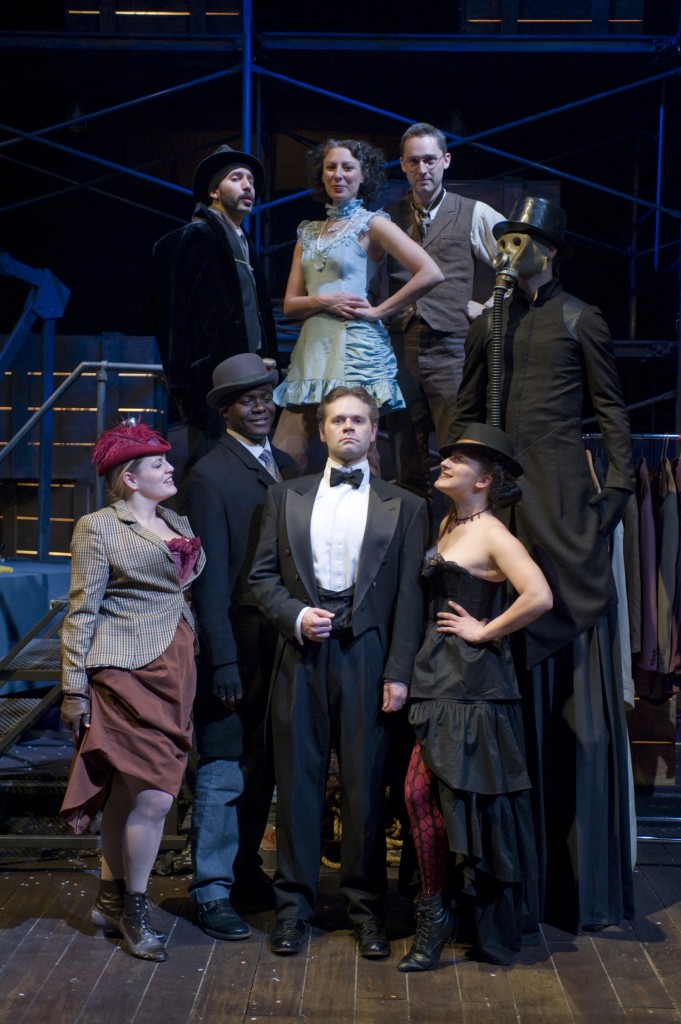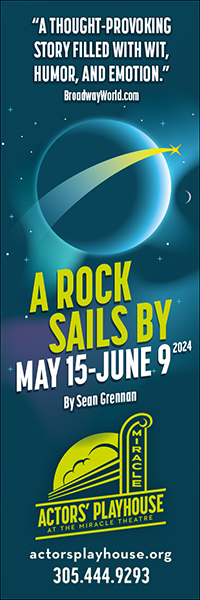By Michelle F. Solomon
There couldn’t be a more fitting space for The House Theatre of Chicago to bring its production of Death and Harry Houdini to South Florida than the Carnival Studio Theater at the Adrienne Arsht Center. The biographical play/magic show embraces the most famous magician of all time’s mad-as-a-hatter life. It brings to the front that mysterious element of “carny,” taking audiences on the journey from his early career as a card-trickster in a sideshow to a household name.
Using the Carnival Studio Theater’s black box space to its advantage, seats are placed on two sides, with a long and narrow stage floor made of wood slats, and brushed to look dusty, like a circus floor. Even before the show opens, audiences are immersed in the intimate vintage setting, its circus banners hung on the back walls, with moving scaffolding that’s used throughout the show in each corner.
When the lights go up, it’s welcome to the big top: “Ladies and Gentleman, Boys and Girls” (although this isn’t a show for the kiddies) as The Ringmaster (a perfectly sinister Johnny Arena) introduces us to the world of Houdini. In playwright Nathan Allen’s original script, death becomes an obsession for Houdini (born Erik Weisz) as we see the pain in the young man’s face as his father suffers, then dies from cancer. Allen’s treatment of the death is pure sideshow, too. Ensemble actor Abu Ansari plays the father whose deathbed is actually a magician’s box. Ansari’s head, arms, feet and hands are exposed, and, then a dreamlike scene is played out. As he takes his last breath, Ansari is sawed in half in the box. How’d they do that? Is it appropriate to clap? Oh, but that magic was so good. Applause.
Death appears as an imposing figure that frequents the play throughout. Covered in a gas mask, actor Kevin Stangler, draped from head to toe in black, is not recognizable. He’s on stilts and, Darth Vader-like comes out of a back curtain through a midst of fog.
The sensory overload in scenes such as this one, are many in Death and Harry Houdini, but it is so carefully crafted that it’s more entertaining, than overwhelming.
The show, however, belongs to magician Dennis Watkins as Houdini. He’s one of those ultra-talented people who has a gift — a gift for entertaining, for illusion, and for believability, immersing himself in the absolute being of Houdini. So much so that, when the show is over, you’ll find yourself Googling Houdini to learn everything about the legend. (I ran home to the iPad to do just that!)
Watkins plays Houdini with a boyish charm, yet bringing out an eccentric side that borders on insanity. Watkins has a thousand tricks up his sleeve, appearing to audiences first hung upside in a straightjacket, and wiggling his way out of it in seconds flat. The sideshow continues as Allen’s script takes Houdini to study with Dr. Lynn, a Chinese sage who has his own bag of tricks. The staging puts Shawn Pfautsch as Lynn (his face completely covered by an oversized traditional straw hat), at one end of the stage on scaffolding, where he performs wonderfully engaging magic tricks while the wide-eyed Houdini watches. “I can learn. I can learn fast,” Houdini tells the old man.
But his mentor’s death sets Houdini over the edge (literally) and he begins performing death-defying feats such as jumping off a bridge with his hands and feet shackled. This is played out before the talented ensemble (Ansari, Arena, and the riotous stand out Trista Smith) who come through at every turn, including frequent stints as a marching band.
There’s plenty of magic throughout performed not only by Watkins, but the other players in the ensemble, and it is methodically placed and perfectly timed to give the audience time to breathe from being consumed by elements of Houdini’s story — such as his marriage to Bess, a dancer who gives up her dreams to devote her life to her husband’s career. Bess is played by the marvelously energetic and talented Carolyn Defrin, who appears as if this role was tailor-made for her. The story takes us through the couple’s dealing with Houdini’s aging mother (an absolutely flawless Marika Mashburn, who only speaks German throughout the play), and delves a bit into the psyche of his younger brother, Theo (Pfautsch as the perfect yin to Watkins’ yang), who has also devoted his life to Houdini’s dreams.
Yet the high point of this perfectly wrapped show — the icing on the cake — is Watkins’ re-enactment of Houdini’s most death defying feat, The Chinese Water Torture Cell, in which he hangs upside down, submerged in a chamber filled with water that is locked from the outside.
This scene, as you can imagine takes mental and physical preparation, as Watkins is lowered head first into the narrow tank. On opening night, an audience member’s cell phone interrupted the prep, but never missing a beat, the actor took a few deep breaths, and sternly reprimanded the phone’s owner. When it went off again, it was quickly confiscated by a member of the House Theater’s stage team. The water torture scene continued without a hitch.
Houdini was a master magician, but the finely crafted work of Death and Harry Houdini is magic in itself. Part drama, part magic show, and all-out entertaining, this is a South Florida, one-of-a-kind event that audiences need to experience before it disappears.
Death and Harry Houdini plays through May 20 at the Carnival Studio Theater in the Adrienne Arsht Center, 1300 Biscayne Blvd., Miami. Performances 7:30 p.m. Wednesday-Saturday, 4 p.m. Sunday. General admission tickets are $40-$50 at arshtcenter.org or call (305) 949-6722.
To read a feature and interviews about the show, click here.
To see clips from the Chicago production, click here and here.








 A PaperStreet Web Design
A PaperStreet Web Design
